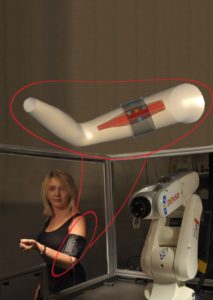Muscle contraction sensor

Dr Simonas Krotkus & Prof. Ifor Samuel | School of Physics & Astronomy
Wearable sensors are desirable for a wide range of medical applications including long-term continuous health monitoring and various robotic tools based on human-machine interactions. Ideally, wearable sensors should be light-weight, compact, flexible, non-invasive, easy to fabricate and low cost. Our work in organic optoelectronic devices suggests a new class of wearable sensors for medicine and sports. A flexible, non-invasive organic optoelectronic device is demonstrated which can be worn on the body to measure signals from muscles and control artificial limbs.
Organic optoelectronic devices exhibit attractive properties of tuneable light emission, easy fabrication on arbitrary, even flexible and stretchable, substrates, and the ability to generate and detect light. We have shown that the combination of organic light-emitting diodes (OLEDs) and organic photodiodes (OPDs) enables compact, non-invasive, flexible sensors for medical applications by simple solution-processing methods. Specifically, we developed a potentially low-cost muscle contraction sensor that can measure signals from intact muscles to control the movement of active prosthetic devices such as artificial limbs. Moreover, we demonstrated the feasibility of this all-organic, optoelectronic sensor by controlling a robotic arm so that it mimicked the motion of a healthy volunteer’s arm for two types of muscle contractions. The sensor measures the amount of light scattered by the skeletal muscle tissue along and parallel to the muscle fibre and can distinguish between isometric (i.e. muscle length remains constant) and isotonic (i.e. the muscle length changes, at a constant exerted force) contractions. Due to the ability to distinguish between different types of contractions, in addition to its non-invasive character and insensitivity to electromagnetic noise, the OLED and OPD based optical sensor is a promising alternative to the surface electromyography technique currently employed to detect the signals from muscles.
Dr Simonas Krotkus
